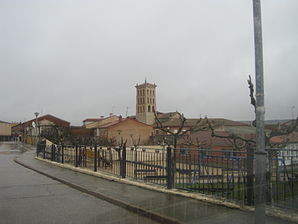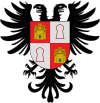Arcos de la Llana
| Arcos de la Llana municipality | ||
|---|---|---|
 Arcos de la Llana - town view
|
||
| coat of arms | Map of Spain | |

|
|
|
| Basic data | ||
| Autonomous Community : |
|
|
| Province : | Burgos | |
| Comarca : | Alfoz de Burgos | |
| Coordinates | 42 ° 16 ′ N , 3 ° 45 ′ W | |
| Height : | 849 msnm | |
| Area : | 31.44 km² | |
| Residents : | 1,734 (Jan 1, 2019) | |
| Population density : | 55.15 inhabitants / km² | |
| Postal code : | 09195 | |
| Municipality number ( INE ): | 09023 | |
| administration | ||
| Website : | Arcos de la Llana | |
Arcos de la Llana is a place and a municipality ( municipio ) with 1,734 inhabitants (as of January 1, 2019) in the province of Burgos in the northern Spanish autonomous region of Castile and León .
location
Arcos de la Llana is located on the Río Ausin in the Castilian plateau ( meseta ) at an altitude of about 850 meters above sea level. d. M. and is about ten kilometers (driving distance) in a south-westerly direction from the city of Burgos . The neighboring village of Villariezo is only about two kilometers northwest.
Population development
| year | 1960 | 1970 | 1981 | 1991 | 2001 | 2008 |
| Residents | 657 | 468 | 313 | 228 | 283 | 901 |
In the second half of the 19th and first half of the 20th century, the population fluctuated between around 550 and 650 inhabitants. Thereafter, the mechanization of agriculture led to a migration of part of the population to the cities. Due to the proximity to Burgos and the comparatively low land prices, the number of inhabitants has increased significantly since the turn of the millennium.
economy
The region has been largely shaped by agriculture for centuries; the inhabitants of earlier times lived mainly as self-sufficient , but handicrafts and retail trade also played a role. One focus was on the cultivation of all kinds of trees, which were ultimately planted all over central Spain.
history
Traces from Roman times indicate the existence of a settlement. No remains have been found from the time of the Great Migration . During the time of the Islamic invasion , the area became depopulated and was only repopulated ( repoblación ) after the reconquest ( reconquista ) in the 10th and 11th centuries . The first written mention of the place name comes from the year 957. On December 9, 1078 Alfons VI transferred. the lordship ( señorio ) over the place to the nearby monastery of San Pedro de Cardeña , but already in 1128 the Archdiocese of Burgos became the sole lord of Arcos.
In 1507 Johanna the Mad stayed with the bones of her husband Philip I in a coffin in the city, which rose to the second most important in the region after Burgos. Several aristocratic landowners built their palaces here, but apart from a few stone heraldic shields ( escudos ), not much has survived . With the dissolution of Spanish church property ( desamortisación ) in the 1830s, episcopal manorial rule over the city also ended.
Attractions
- The parish church consecrated to the Archangel Michael ( Iglesia de San Miguel Arcángel ) has an impressive tower in the Mudejar style that is visually and statically loosened up by a multitude of arcades , the upper part of which is made of bricks ; its lower part - made of more or less precisely hewn natural stones - dates from the high Middle Ages. The actual church building with its old south portal is Romanesque in its ground plan , but a west portal designed in a strict baroque style was added to the medieval building fabric in 1657 , which can basically be described as classicistic . The three-aisled interior of the church was also redesigned during this time - Gothic-looking columns end in star vaults with hanging keystones . The central apse and the flat ends of the two side aisles were furnished with huge altarpieces .
- The almost ruined building called Torreón de los Gallos is located a little outside of Arcos; it essentially dates from the early 16th century, although the mighty and almost windowless corner tower ( torre de homenaje ) was also built in the High Middle Ages and could have been integrated into the newly built palace.
- From the late medieval city wall, three gates and a few short sections have been preserved.
- Several houses in the town center are decorated with stone coats of arms, but most of them are in a poor state of preservation.
- A two-arched stone bridge leads over the Río Ausín. It also served as a safe crossing for the wandering flocks of sheep.
Web links
- Arcos de la Llana, historical buildings - photos + information (Spanish)
- Arcos de la Llana, historical buildings - photos + information (Spanish)
- Arcos de la Llana, church and coat of arms - photos
Individual evidence
- ↑ Cifras oficiales de población resultantes de la revisión del Padrón municipal a 1 de enero . Population statistics from the Instituto Nacional de Estadística (population update).



